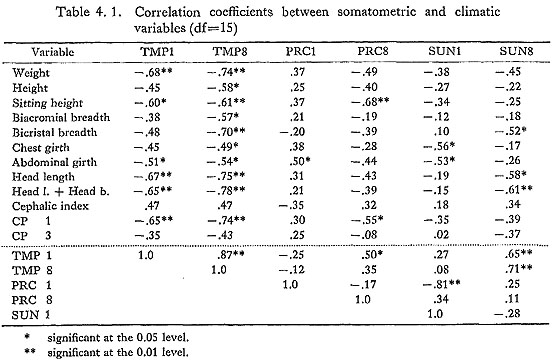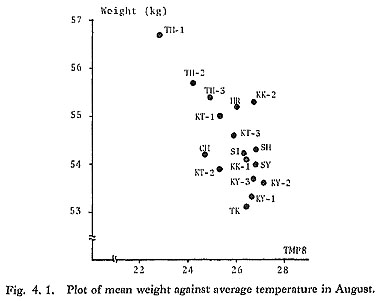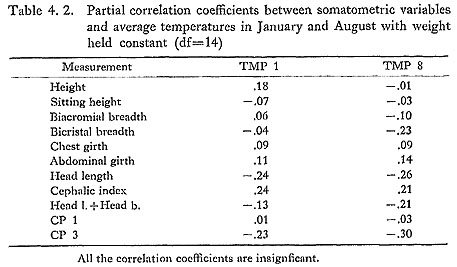CHAPTER 4
Climatic Relations
|
It has been generally held that geographic variation in the somatometric data of modern Japanese is attributable to chiefly genetic factors; the importance of environmental factors seems to have been neglected. For example, on the assumption that the characteristics of a population are fixed and unchangeable, inter-population difference has been considered to experss genetic difference, and thus to reflect the phylogeny. However, studies of immigrants and of secular change strongly suggest that somatometric traits can change drastically with a change of environment. Better nutrition, improved living conditions and medical care, and climate have all been mentioned as causative factors. In this and the next chapters, the association of somatometric data and two environmental factors, climate and nutrition, is examined. In other words, this is an attempt to explain the geographic variation in terms of factors other than genetic ones. The relationships between the body size or body shape of a polytypic warm-blooded species and the climate of its habitat are known respectively as Bergmann's rule and Allen's rule. Bergmann's rule states that the body size of a warm-blooded species increases with decrease of mean temperature, because greater body size, and thus a greater ratio of body mass (relating to heat production) to body surface area (relating to heat loss), is advantageous in a cold habitat. Significant correlations between weight or weight/body-surface-area and climate have been reported, and the rule is considered to some extent applicable to humans in spite of their cultural and physiological adaptation to climate (Schreider, 1950, 64, 75; Roberts, 1953, 78; Newman and Munro, 1955; Crognier, 1981). Since the present study indicated significant correlation between. body size and latitude in the Nishi male series, it is probable that at least part of geographic variation in body size can be explained by Bergmann's rule. Allen's rule states that the relative size of protruding organs such as ears, muzzle or limbs increases with increase of mean temperature, and is also interpreted in terms of body heat regulation. In the human species, the rule has been used to explain racial differences in head shape and physique (Roberts, 1978; Steegmann, 1975; Coon et al., 1950). The purpose of this chapter is to clarify whether the geographic variation revealed in the previous chapter can be explained in terms of the above two rules by examining the correlation coefficients between somatometric variables and climatic ones. 1. Materials and MethodsThe climatic variables are as follows:
Mean values for the period from 1941 to 1970 were used. The values were obtained for each of the 17 areas by averaging the values reported by the meteorological stations in the area. Data from high mountains such as Mt. Fuji were not used. Correlation coefficients between above 6 climatic variables and somatometric ones were calculated. Partial correlations were calculated as needed. 2. ResultsTable 4.1 shows the correlation coefficients between somatometric variables and the climatic ones. Weight, head length, head length+head breadth and CP1 (body size factor) are significantly correlated with TMP1 and TMP8 at the 1% level. Sitting height, bicristal breadth and abdominal girth also show correlation with TMP1 and TMP8. Precipitation and sunshine showed insignificant or low correlation with somatometric variables, and are considered to be unimportant.
Figure 4.1 shows a linear relationship between weight and average temperature in August. This indicates the geographic variation in body size of modern Japanese to be compatible with Bergmann's rule.
Body weight is said to have primary association with temperature (Roberts, 1953), and most of the somatometric variables which show significant correlation with temperature are also correlated with body weight. When the latter was partialed out, the correlations between these somatometric variables and temperature became insignificant (Table 4.2). Consequently, the association between temperature and somatometric variables other than weight is considered to be a secondary one.
Cephalic index does not show significant correlation with the climatic variables. Brachycephaly with a relatively small surface area is theoretically more advantageous in a colder area, and Beals, after surveying the world-wide distribution of the cephalic index, found an association between brachycephaly and cold (Beals, 1972). In Europe and Africa, head lengths are not correlated with temperature, but head breadth and cephalic index tend to be small in hot dry areas (Hiernaux and Froment, 1976; Crognier, 1981). In the Nishi male series, not only is the correlation between cephalic index and temperature insignificant, but the gradient suggested by the correlation is also opposite to the one expected theoretically: more dolychocephalic heads in colder areas. Thus, the geographic variation in the cephalic index cannot be explained by Allen's rule. 3. Summary and Conclusions
|


